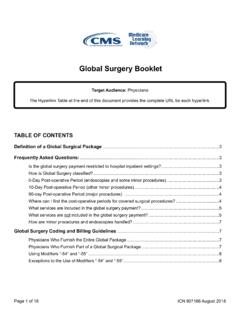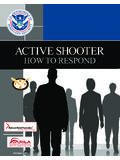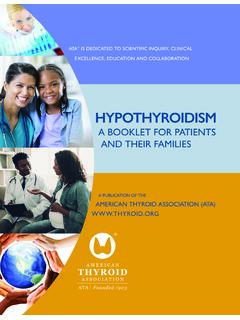Transcription of A Guide to Scaffold Use in the Construction Industry
1 A Guide to Scaffold Use in the Construction Industry Small Business Safety Management Series OSHA 3150 2002 (Revised) This informational booklet is intended to provide a generic, non-exhaustive overview of a particular standards-related topic. This publication does not itself alter or determine compliance responsibilities, which are set forth in OSHA standards themselves and the Occupational Safety and Health Act of 1970. Moreover, because interpretations and enforcement policy may change over time, for additional guid-ance on OSHA compliance requirements, the reader should consult current administrative interpretations and decisions by the Occupational Safety and Health Review Commission and the courts.
2 Material contained in this publication is in the public domain and may be reproduced, fully or partially, without permission of the Federal Government. Source credit is requested but not required. This information will be made available to sensory impaired individuals upon request. Voice phone: (202) 219-8615; Teletypewriter (TTY): (887) 889-5627 A Guide to Scaffold Use in the Construction Industry Small Business Safety Management Series of Labor Occupational Safety and Health Administration OSHA 3150 2002 (Revised) Contents iii How to Use This booklet .
3 V Summary .. 1 General Requirements for Scaffolds .. 3 Capacity .. 3 Scaffold Platform Construction .. 3 Criteria for Supported 4 Criteria for Suspended Scaffolds .. 4 Access Requirements .. 7 Use Requirements .. 7 Fall Protection Requirements .. 7 Falling Object 8 Specific Scaffold and Aerial Lift Requirements .. 9 Training Requirements .. 10 Non-Mandatory Appendices to the Standard .. 11 OSHA Assistance, Services, and Programs .. 12 Safety and Health Program Management Assistance .. 12 State Plans .. 12 Consultation 12 Voluntary Protection Programs.
4 13 OSHA s Strategic Partnership Program .. 14 Training and Education .. 15 Other Assistance Materials .. 15 OSHA Regional and Area Offices .. 16 OSHA-Approved Safety and Health Plans .. 21 OSHA Onsite Consultation Offices .. 23 Construction Focused Inspection Guidelines .. 28 Regulatory Text .. 29 Contents How to Use This booklet vThe Occupational Safety and Health Act of 1970 charges the Occupational Safety and Health Admin-istration (OSHA) with protecting all working men and women across the United States. To do so, the agency sets federal standards1 for general Industry , Construction , and shipyard employment.
5 OSHA also promotes a variety of voluntary programs that strive to form partnerships with businesses, labor, and other groups to help employers provide safer and more healthful workplaces for employees. Some of the agency s voluntary initiatives include safety and health management programs, the Voluntary Protec-tion Programs, consultation assistance, and training and education programs and grants. For more information on these outreach efforts, see page 12 of this booklet . The agency s recent rule, Safety Standards for Scaffolds Use in the Construction Industry rule aims to protect workers using scaffolding in Construction work.
6 Scaffolding hazards continue to rank high on the list of the most frequently cited standards in the Construction Industry . Scaffold -related fatalities account for a significant number of fatalities in the 1 Section 18(b) of The Occupational Safety and Health Act of 1970, 91-596, encourages states to develop and operate, under OSHA guidance, their own job safety and health plans. An OSHA-approved state plan must have safety and health requirements at least as effective as those of Federal OSHA and must adopt comparable state standards within 6 months of promulgation of federal standards.
7 Construction workplace. This booklet addresses some of the most common questions about OSHA s Scaffold standard. It is all part of the agency s effort to provide guidance to employers who need help in complying with OSHA s standards to protect the working men and women across the nation. This booklet is organized in a question and answer format to highlight pertinent information that employers and employees need to know. The subjects addressed in each question follow the basic organization of the standard. In addition, each answer references the regulatory text where that particular information can be located.
8 These refer-ences appear at the end of each answer in boldface type. An appendix also includes an alphabetical index to the standard for quick reference. It is important to note that the question and answer section of this booklet simply provides an overview of the standard. For compliance with all of the regulation s requirements, refer to the regula-tory text or Title 29 of the Code Federal Regulations (CFR) Part 1926, Subpart L. How to Use This booklet 1 Summary and Explanation of the Final Rule What are the highlights of the scaffolding Training Employers must train each employee standard?
9 Who works on a Scaffold on the hazards and the OSHA s scaffolding standard has several key provisions: Fall protection or fall arrest systems Each em-ployee more than 10 feet above a lower level shall be protected from falls by guardrails or a fall arrest system, except those on single-point and two-point adjustable suspension scaffolds. Each employee on a single-point and two-point adjustable suspended Scaffold shall be protected by both a personal fall arrest system and a guardrail. (g)(1) Guardrail height The height of the toprail for scaffolds manufactured and placed in service after January 1, 2000 must be between 38 inches ( meters) and 45 inches ( meters).
10 The height of the toprail for scaffolds manufactured and placed in service before January 1, 2000 can be between 36 inches ( meters) and 45 inches ( meters). (g)(4)(ii) Crossbracing When the crosspoint of crossbracing is used as a toprail, it must be between 38 inches ( m) and 48 inches ( meters) above the work platform. (g)(4)(xv) Midrails Midrails must be installed approxi-mately halfway between the toprail and the platform surface. When a crosspoint of crossbracing is used as a midrail, it must be between 20 inches ( meters) and 30 inches ( m) above the work platform.


















